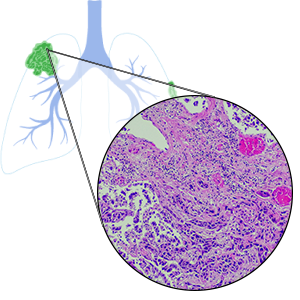Squamous Cell Carcinoma Lung Cancer
Squamous cell carcinoma is a cancer that develops on the surface of certain parts of the body, particularly the lungs. Squamous cell carcinoma in the lungs can be life-threatening without proper medical care. Learn more about this cancer and get help affording treatments now.
What Is Squamous Cell Carcinoma in Lung Cancer?
 Squamous cell carcinoma is a type of cancer that develops in the squamous cells, which are thin, flat cells found in the skin and the tissue lining hollow organs.
Squamous cell carcinoma is a type of cancer that develops in the squamous cells, which are thin, flat cells found in the skin and the tissue lining hollow organs.
Squamous cell carcinoma can develop in many different parts of the body, including the skin, genitals, and lungs. When squamous cell caricnoma forms in the lungs, it’s also known as squamous cell lung carcinoma or squamous cell lung cancer.
Squamous cell lung cancer is a subtype of non-small cell lung cancer (NSCLC), which is one of two main types of this cancer, according to Yale Medicine. Squamous cell carcinoma accounts for 25%-30% of NSCLC cases.
Squamous cell carcinoma of the lung can be very dangerous and even deadly. Thankfully, there is medical treatment available to help you after a diagnosis. Learn if you qualify to get financial aid for lung cancer treatments through a free case review.
- Access Financial Aid and Justice
- Learn About Your Options
- Contact Us for Free

Causes of Squamous Cell Carcinoma
Smoking cigarettes is the overall biggest cause of squamous cell lung cancer. Around 80% of squamous cell lung carcinoma cases in men and 90% of cases in women are associated with smoking.
Smoke contains carcinogens (cancer-causing substances) that severely damage the body and can mutate healthy cells.
“Squamous cell carcinoma is more closely associated with smoking than any other type of lung cancer.”
— Yale Medicine
Besides smoking, exposure to secondhand smoke, radon, asbestos, and other toxic substances may all increase the risks of developing squamous cell lung cancer, according to Harvard Medical School.
Asbestos is a particularly insidious cause of squamous cell carcinoma. Between the 1930s and early 1980s, asbestos was used in thousands of products found in homes, ships, and cars. Those who worked around asbestos could inhale tiny fibers, which get stuck in the body and damage healthy lung tissue.
Signs & Symptoms of Squamous Cell Lung Cancer
Squamous cell lung carcinoma shares symptoms with the other types of NSCLC.
- Cough and/or chest pain that won’t go away
- Coughing up blood or mucus
- Fatigue
- Hoarseness
- Loss of appetite
- Pain when swallowing
- Shortness of breath
- Unexplained weight loss
- Wheezing
Patients might also experience recurring lung infections like bronchitis and pneumonia.
Squamous cell lung carcinoma is often diagnosed in a later stage (when it’s harder to treat) because symptoms don’t usually appear until the cancer spreads.
If you have possible symptoms of squamous cell lung carcinoma, don’t wait: See a doctor immediately and tell them of your concerns.
Diagnosing Squamous Cell Carcinoma of the Lung
If a doctor suspects you have squamous cell carcinoma, they may perform one or more tests to reach a diagnosis. First, doctors will want to know about your overall health history.
Be sure to tell your doctors:
- Which symptoms of squamous cell carcinoma you have (if any)
- When the symptoms began
- If you smoke (or used to smoke)
- If you may have been exposed to asbestos or other carcinogens
From there, your doctors may recommend a series of imaging scans to look inside your lungs for possible signs of squamous cell carcinoma.
Imaging Scans & Biopsies for Squamous Cell Carcinoma
Different types of imaging tests can be used to help diagnose squamous cell lung cancer.
Commonly used tests include:
- X-rays: This is typically the first imaging scan performed if squamous cell lung carcinoma is suspected, according to Harvard Medical School. A low dose of radiation is used to take a picture of the inside of your body. However, Corewell Health notes that squamous cell carcinoma might not show up on an X-ray if it’s in an early stage.
- Computed tomography (CT) scans: A CT scan uses a machine to take a series of photos of your body’s insides from different angles.
- Magnetic resonance imaging (MRI) scans: An MRI uses radio waves, a computer, and a powerful magnet to take pictures of your body.
- Positron emission tomography (PET) scans: PET scans specifically help doctors see the soft tissue within the body. Some hospitals use combined PET-CT scanners.
Doctors will then order a biopsy if they believe you might have lung cancer based on the results of the imaging scans.
A biopsy is a procedure where a provider removes a sample of abnormal tissue. A specialist will look at the tissue under a microscope to identify cancer cells. This test allows doctors to confirm if you have squamous cell carcinoma (or any other type of lung cancer).
Get help affording medical treatments after a squamous cell carcinoma diagnosis. Call (877) 446-5767 now to learn more.
Misdiagnosing Squamous Cell Carcinoma
Some health care providers may misdiagnose squamous cell carcinoma, especially because the symptoms could be mistaken for more common and less serious health problems. For example, this cancer could be misdiagnosed as a cold or bronchitis.
A squamous cell carcinoma misdiagnosis can delay proper diagnosis and treatment. Consider getting a second opinion from another doctor if you believe your condition has been misdiagnosed.
Stages of Squamous Cell Carcinoma
Like all other types of NSCLC, squamous cell carcinoma can be classified into one of five stages. Higher stages mean that the cancer has spread further from where it started.
Sqaumous cell carcinoma tumors usually form in the center of the lung and spread from there.
The stages of squamous cell lung carcinoma include:
- Stage 0: Cancer cells are found on one part of a lung and nowhere else
- Stage I: The cancer has grown into a tiny tumor on the lung
- Stage II: The tumor has gotten bigger and may or may not be found in nearby lymph nodes
- Stage III: The tumors have spread into lymph nodes and possibly other body parts
- Stage IV: The cancer has spread outside of the lungs and throughout the body
Patients typically have fewer treatment options available if they have a higher squamous cell carcinoma stage. That said, medical care can help patients at any stage. Learn how to afford treatments with a free case review.
- Access Financial Aid and Justice
- Learn About Your Options
- Contact Us for Free




Squamous Cell Carcinoma Lung Prognosis
The prognosis (long-term health outcome) for squamous cell lung cancer is generally poor. That said, it’s still possible for some patients to live for years or even decades after a diagnosis.
Learn about common survival statistics that make up a squamous cell carcinoma prognosis below.
Life Expectancy With Squamous Cell Lung Carcinoma
Life expectancy is how long your doctor thinks you’ll live considering how far the cancer has spread, your general health, and other factors.
Life expectancy is generally higher for those with early-stage squamous cell carcinoma — these patients can possibly live for many years if they receive aggressive treatments. Those diagnosed with late-stage carcinoma might only live for a few months.
Doctors can provide a more specific life expectancy depending on the factors unique to your case.
Survival Rate for Patients With Squamous Cell Carcinoma Tumors
Survival rate is the percentage of patients still alive after a certain amount of time has passed.
The average five-year survival rate for squamous cell lung cancer is only 24%, according to Harvard Health Publishing. But, medical care may be able to help you outlive the average survival rate.
Squamous Cell Lung Carcinoma Treatments
There are multiple cancer treatments for squamous cell lung cancer. Which lung cancer treatments will be most effective for you or a loved one depends on many factors, such as your age, overall health status, stage of the cancer, and more.
The best doctors for squamous cell carcinoma will take into account all of the factors listed above before recommending treatments. Learn about top treatments for squamous cell carcinoma below.
Surgery
Surgery will allow a doctor to remove squamous cell carcinoma tumors from your body. To do so, they may need to remove part or all of the lung in which the cancer tumor has formed.


Surgery can possibly cure a patient of squamous cell carcinoma or other types of NSCLC, according to the medical journal Lung India. However, lung cancer tumors recur (grow back) in 30%-77% of patients treated with surgery.
Chemotherapy
Chemotherapy uses powerful chemicals to kill cancerous cells and reduce the size of tumors. This type of treatment can be used for all stages of squamous cell carcinoma, according to the U.S. National Library of Medicine.
Chemotherapy is often used to boost the effects of surgery in the early stages of this cancer. Late-stage squamous cell lung cancer patients typically receive chemotherapy as their main form of treatment.
Radiation Therapy
Radiation therapy uses beams of energy (like X-rays) to damage squamous cancer cells’ ability to spread.
Radiation therapy can be used in the early stages of squamous cell carcinoma after surgery or to treat patients who can’t receive surgery. In fact, the U.S. National Library of Medicine notes that some early-stage cases can be cured using just radiation.
Patients with late-stage squamous cell lung cancer may receive radiation therapy alongside chemotherapy. Those with metastatic (widespread) cancer typically get palliative (pain-relieving) radiation treatments, while still receiving chemotherapy to try and help them live longer.
Our team can help you get financial aid to afford the squamous cell carcinoma treatments listed above. Get a free case review now to learn more.
- Access Financial Aid and Justice
- Learn About Your Options
- Contact Us for Free




Find Help for Squamous Cell Carcinoma Patients
Getting diagnosed with squamous cell lung carcinoma can bring a lot of stress and anxiety into your life. Fortunately, Lung Cancer Group is here to help.
If you or a loved one has squamous cell carcinoma, another type of lung cancer, or other diseases caused by asbestos, we can help you pursue financial compensation for your medical expenses and other bills.
Get a free case review now to kickstart the process.
Squamous Cell Carcinoma FAQs
Who is at risk for squamous cell carcinoma?
People who smoke and/or were exposed to secondhand smoke, radon, asbestos, or other carcinogens are more likely to develop squamous cell lung carcinoma.
Yale Medicine also notes that a family history of lung cancer, a diagnosis of HIV or AIDS, and environmental toxins all increase the risks of developing squamous cell carcinoma and other types of NSCLC.
How common are squamous cell lung carcinoma tumors?
Squamous cell carcinoma tumors are the second-most common type of lung cancer. Between 25% and 30% of all NSCLC patients have squamous cell lung carcinoma.
Our team estimates that between 48,800 and 58,600 people are diagnosed with squamous cell lung cancer each year.
Is squamous cell carcinoma of the lungs curable?
Yes, according to the U.S. National Library of Medicine, some patients may be considered cured if their cancer is diagnosed in an early stage. Surgery, chemotherapy, and radiation therapy can all help to cure patients.
Squamous cell carcinoma of the lung is typically hard to cure if it’s metastasized, though.
How fast does squamous cell carcinoma spread?
Squamous cell carcinoma of the lung generally spreads quickly. Tumors can double in size within 70 days, according to a 2018 report from the Journal of Thoracic Disease.
However, this cancer spreads slower than small cell lung cancer does.
Are squamous cell lung carcinoma tumors always fatal?
No, squamous cell carcinoma tumors of the lung are not always fatal. However, it’s important to get medical care as soon as possible. Doing so will allow you to get medical treatments needed to possibly get cured or live longer.

